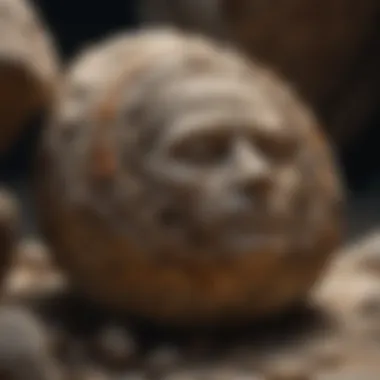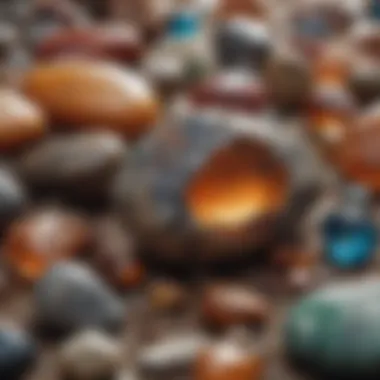Enhancing Rock and Fossil Collections with Jewels: A Guide to Using Glue


Rock and Fossil Identification
When delving into the captivating world of rock and fossil collecting, identifying the different types of rocks and fossils is crucial for enthusiasts. Understanding the characteristics to look for in these geological wonders enhances the collecting experience. Utilizing tools specifically designed for identification, such as magnifying lenses and hardness testers, adds precision to the process, ensuring collectors can differentiate between various specimens in their collections.
Collecting Tips and Techniques
Embracing best practices when collecting rocks and fossils elevates the hobby to a more informed and sustainable level. Knowing how to locate prime collecting sites, whether through research or networking with fellow collectors, is a valuable skill. Safely extracting specimens without causing damage to them or the surrounding environment requires technique and care, emphasizing the importance of ethical collecting methods.
Preservation and Display
Preserving rocks and fossils is essential for maintaining their integrity and beauty over time. Using techniques such as cleaning with gentle brushes and proper storage methods, including archival-quality containers, helps protect specimens from degradation. Creative display ideas, such as shadow boxes or curated shelves, enhance the visual appeal of collections while showcasing the diversity and uniqueness of each rock or fossil.
Geological Insights
Exploring geological formations and processes provides valuable context to rock and fossil collecting. Understanding the historical significance of certain rocks and fossils offers a glimpse into Earth's past and the evolution of life. Notable discoveries in the field serve as inspiration for collectors, highlighting the endless possibilities and mysteries waiting to be uncovered in the world of geology.
Introduction
In the intricate world of rock and fossil collecting, the utilization of glue for securing jewels holds immense significance. This article delves deep into the art of enhancing the presentation and longevity of geological treasures through the strategic application of adhesives. By exploring the various types of adhesives suitable for different materials and providing expert insights on application techniques, collectors will glean valuable knowledge on elevating their prized collections.
Significance of Using Glue for Jewels in Rock and Fossil Collections
Enhancing Aesthetics
Enhancing aesthetics within rock and fossil collections is a pivotal aspect that resonates profoundly with enthusiasts. The meticulous placement of jewels using glue not only adds a visual allure to specimens but also elevates their overall artistic appeal. By carefully selecting adhesives that complement the colors and textures of the minerals and fossils, collectors can create visually captivating displays that highlight the natural beauty of each piece. The precision and delicacy required in enhancing aesthetics through glue application speaks to the dedication of collectors in showcasing their treasures with finesse and sophistication.
Securing Fragile Specimens
Securing fragile specimens within rock and fossil collections is imperative to preserving these delicate treasures. The use of glue provides a stable and secure bond that safeguards fragile jewels from potential damage or dislodgment. By employing appropriate adhesives that offer both strength and flexibility, collectors can ensure that their specimens remain intact and protected, enhancing the longevity of their displays. Securing fragile specimens with glue underscores the meticulous care and attention to detail that collectors invest in safeguarding their prized geological finds.
Preservation Purposes
Preservation purposes serve as a primary driving force behind the use of glue in rock and fossil collections. By carefully applying adhesives to reinforce fragile areas or seal cracks in specimens, collectors can prevent further deterioration and maintain the integrity of their treasures. The protective barrier created by glue not only aids in preserving the physical form of specimens but also shields them from environmental factors that could compromise their structural integrity. The application of glue for preservation purposes underscores the commitment of collectors to conserving their geological artifacts for future generations to admire and study.
Types of Adhesives


In the realm of rock and fossil collections, the choice of adhesive plays a critical role in ensuring the longevity and aesthetic appeal of secured jewels. Understanding the nuances of different types of adhesives is paramount for collectors who seek to enhance the presentation and preservation of their geological treasures.
Cyanoacrylate Adhesives
Quick-Drying Formula
Cyanoacrylate adhesives, known for their quick-drying formula, offer a swift adhesive solution for attaching jewels to rocks and fossils. This rapid bonding characteristic significantly expedites the application process, ensuring efficient placement and stability. Despite their quick setting time, careful precision is advised during application to avoid any mishaps.
Excellent for Hard Materials
The exceptional bonding strength of cyanoacrylate adhesives makes them a preferred choice for hard materials. Whether securing precious gems onto rigid surfaces or affixing jewels to sturdy rock formations, the durable bond provided by cyanoacrylate adhesives ensures a secure attachment that withstands the test of time.
Precision Application
The precision application capability of cyanoacrylate adhesives enables collectors to delicately position jewels with accuracy. This meticulous approach is particularly beneficial when dealing with intricate or fragile specimens, allowing for pinpoint placement without causing damage. However, the quick adhesive properties may require cautious handling to prevent unintended adhesion.
Epoxy Resin
Strong Bonding Strength
Epoxy resin stands out for its impressive bonding strength, offering a reliable adhesive option for bonding jewels to various rock and fossil substrates. The robust bond created by epoxy resin ensures long-lasting adhesion, ideal for securing jewels in high-traffic areas or on specimens subject to handling.
Versatile Usage
The versatility of epoxy resin extends to its usage across a broad range of materials, making it a versatile choice for collectors working with diverse jewel and substrate combinations. Whether attaching gems to porous rocks or fossils with uneven surfaces, the adaptability of epoxy resin enables secure and seamless adhesion.
Adhesive Mixing Considerations
Attention to adhesive mixing considerations is crucial when working with epoxy resin to ensure optimal bonding results. Proper ratio adherence and thorough mixing are essential for activating the adhesive properties and achieving a strong bond between jewels and substrates. However, the meticulous mixing process may require precision to avoid inconsistencies in bonding strength.
Silicone Adhesives
Flexibility
Silicone adhesives offer a flexible bonding solution, particularly beneficial for adhering jewels to surfaces that experience movement or flexibility. The elasticity of silicone adhesives accommodates substrate shifts without compromising the bond integrity, making them an ideal choice for specimens prone to environmental stressors.


Water-Resistant Properties
The water-resistant properties of silicone adhesives make them a reliable option for collectors looking to secure jewels in moisture-prone environments. Whether placing gems on rocks exposed to damp conditions or fossil specimens susceptible to humidity, silicone adhesives provide a protective barrier against water damage, ensuring long-term preservation.
Non-Corrosive Nature
Silicone adhesives boast a non-corrosive nature, safeguarding both jewels and substrates from chemical reactions or deterioration over time. This non-invasive adhesive quality ensures that the integrity of precious gems and geological specimens remains intact, minimizing the risk of discoloration or degradation. However, meticulous application is advised to achieve optimal bonding outcomes without excess adhesive residue.
Application Techniques
In the realm of rock and fossil collecting, the application techniques play a crucial role in the successful integration of jewels onto specimens. The precise application of adhesive is essential for securing these valuable embellishments. Through a meticulous process of surface preparation, precise jewel placement, and proper drying and curing, collectors can enhance the beauty and longevity of their geological treasures.
Surface Preparation
- Cleaning: Cleaning the surface where the jewels will be attached is a fundamental step in ensuring a strong bond. By removing any dirt, oils, or debris, the adhesive can adhere better to the material, ensuring a secure attachment. This meticulous cleaning process is essential for maximizing the adhesive's effectiveness and longevity of the bond.
- Roughening: Roughening the surface provides a textured area for the adhesive to grip onto, increasing the contact area and enhancing the bond strength. This process is especially effective for smooth or non-porous surfaces, enhancing the overall adhesion and durability of the jewels.
- Alignment: Proper alignment of the jewels is crucial for achieving a visually appealing and balanced composition. Aligning the jewels precisely ensures a cohesive look and prevents any misplacement that could affect the overall aesthetics of the specimen. Attention to detail during the alignment process is key to creating a harmonious display.
Precise Placement of Jewels
- Using Tweezers: Employing tweezers for precise jewel placement allows collectors to delicately position each gem with accuracy. The use of tweezers enables collectors to place jewels in intricate patterns or arrangements, showcasing each piece with attention to detail.
- Avoiding Excessive Pressure: Applying excessive pressure when placing jewels can lead to damage or misalignment. By gentle handling and avoiding undue pressure, collectors can ensure the longevity of both the jewels and the specimen, maintaining the integrity of the display.
- Considering Weight Distribution: Distributing the weight of the jewels evenly across the specimen helps prevent strain or imbalance. Strategic placement considering weight distribution is crucial for preserving the structural integrity of the specimen, especially when dealing with fragile or delicate materials.
Drying and Curing Process
- Optimal Time Frame: Allowing the adhesive to dry and cure for the recommended time frame ensures a strong and stable bond between the jewels and the specimen. Rushing this process can compromise the integrity of the attachment, potentially leading to detachment or instability.
- Ensuring Stability: Stabilizing the specimen during the drying and curing process is essential for preventing any movement that could disrupt the adhesive bond. Ensuring stability throughout the drying period guarantees a secure attachment, maintaining the visual appeal of the display.
- Post-Application Inspection: After the adhesive has dried, a thorough post-application inspection is necessary to verify the stability and quality of the bond. Inspecting for any signs of weakness or detachment allows collectors to address any issues promptly, ensuring the long-term durability and aesthetic appeal of the display.
Expert Tips and Best Practices
In the realm of rock and fossil collections, adhering jewels with precision and care is a vital aspect of preservation and presentation. Expert tips and best practices play a crucial role in ensuring that the adhesive not only secures the jewels effectively but also maintains the integrity of the specimens. By paying attention to specific elements and considerations outlined in this article, collectors can significantly enhance the aesthetics and longevity of their geological treasures.
Avoiding Overuse of Adhesive
Minimal Application
Minimal application is a key strategy to prevent excessive use of adhesive, which can have detrimental effects on the appearance and preservation of jewels in rock and fossil collections. By utilizing a minimal amount of adhesive, collectors can achieve secure bonding without overpowering the natural beauty of the specimens. The primary benefit of minimal application is the preservation of the visual appeal and authenticity of the jewels. It ensures that the adhesive remains inconspicuous while providing adequate strength for bonding. However, a disadvantage of minimal application is the need for precise application techniques to ensure effective bonding without using excessive adhesive.
Strategic Placement


Strategic placement involves carefully positioning jewels on rocks and fossils to optimize both visual impact and structural integrity. By strategically placing jewels in areas that enhance the overall composition, collectors can create captivating displays that highlight the unique features of each specimen. The key characteristic of strategic placement is the ability to balance aesthetic appeal with functional stability. This approach is popular among collectors as it allows them to showcase their jewels in a harmonious and visually appealing manner. One advantage of strategic placement is the ability to create cohesive arrangements that engage viewers, providing a sense of balance and beauty. However, a potential disadvantage is the time and precision required to ensure each jewel is placed strategically without compromising the overall composition.
Experimenting with Arrangements
Creating Visual Impact
Creating visual impact through jewel arrangements is a critical aspect of rock and fossil collecting, especially when utilizing glue for securing jewels. By carefully arranging jewels to draw attention to unique features and geometric patterns, collectors can elevate the aesthetic appeal of their specimens. The key characteristic of creating visual impact is the ability to evoke curiosity and admiration through thoughtful placement and juxtaposition of jewels on rocks and fossils. This approach is beneficial for collectors looking to create visually striking displays that highlight the beauty and individuality of each specimen. However, a potential disadvantage of focusing solely on visual impact is the risk of compromising the structural integrity of the specimens if not done with care.
Balancing Compositions
Balancing compositions involves harmonizing the arrangement of jewels on rocks and fossils to ensure a cohesive and visually pleasing display. By considering factors such as color, size, shape, and texture, collectors can achieve balance in their compositions, creating aesthetically pleasing vignettes that engage the viewer. The key characteristic of balancing compositions is the ability to create dynamic arrangements that guide the viewer's eye across the specimen, highlighting its various features. This approach is popular among collectors seeking to showcase their jewels in a holistic and balanced manner. An advantage of balancing compositions is the visual coherence it brings to displays, enriching the overall viewing experience. However, a potential disadvantage is the challenge of achieving balance without overcrowding or overwhelming the specimen.
Seeking Professional Guidance if Necessary
Consulting Conservators
Consulting conservators can provide valuable expertise and guidance on the use of adhesives in rock and fossil collections, ensuring that the preservation and display of jewels are conducted with care and consideration. The key characteristic of consulting conservators is their specialized knowledge in materials conservation, allowing them to offer tailored advice on adhesive selection and application techniques. This choice is beneficial for collectors seeking professional insights into preserving their geological treasures for the long term. An advantage of consulting conservators is the assurance of expert recommendations that align with best practices in conservation. However, a potential disadvantage is the associated cost and logistics of engaging professional conservators for consultation.
Using Reversible Adhesives
Utilizing reversible adhesives offers collectors the flexibility to adjust and reposition jewels on rocks and fossils without compromising the specimens' integrity. The key characteristic of reversible adhesives is their ability to provide secure bonding while allowing for easy removal and reapplication if needed. This choice is popular among collectors who value the versatility and temporary nature of the adhesive bond. An advantage of using reversible adhesives is the freedom to experiment with different arrangements and compositions without permanent consequences. However, a potential disadvantage is the need for careful monitoring and maintenance to ensure the adhesive's stability over time.
Conclusion
Elevating Your Rock and Fossil Collection
Balancing Artistry and Preservation
The synthesis of artistry and preservation is a paramount consideration in enhancing the allure of rock and fossil collections. Balancing these two elements ensures that the beauty and integrity of specimens are maintained while also offering a visually appealing presentation. The key characteristic of this balance lies in the meticulous application of adhesive to securely attach jewels without compromising the authenticity of the specimens.
Striking a harmonious equilibrium between artistic embellishment and scientific accuracy is a delicate yet rewarding task for collectors. By opting for a conservative approach in adorning specimens with jewels, enthusiasts can highlight their intrinsic beauty and historical significance without overshadowing the natural features of the rocks or fossils. This careful curation enhances the overall visual impact of the collection while preserving the essence of each specimen, making it a preferred choice for collectors seeking a blend of aesthetic appeal and scholarly value.
The unique feature of balancing artistry and preservation lies in its ability to elevate rock and fossil displays beyond mere arrangement into artistic masterpieces with educational merit. While the advantages of this approach include enhancing the attractiveness of collections and offering a nuanced narrative of each specimen's origin, collectors must be mindful not to compromise the scientific integrity of the artifacts for the sake of embellishment.
Showcasing Unique Specimens
Showcasing unique specimens is an essential aspect of rock and fossil collections, offering collectors the opportunity to highlight the rare and remarkable finds within their assemblage. This segment of collection presentation magnifies the individuality of each specimen, emphasizing its distinct characteristics and historical significance.
The key characteristic of showcasing unique specimens is the meticulous selection and placement of jewels to draw attention to specific features or attributes of the rocks or fossils. By strategically positioning embellishments to accentuate the most intriguing aspects of a specimen, collectors can create focal points that showcase the uniqueness of each geological treasure.
This deliberate approach not only enhances the visual appeal of the collection but also serves as a testament to the diversity and splendor of Earth's geological formations. Showcasing unique specimens offers collectors a means to share the beauty and intrigue of their finds with others, sparking curiosity and admiration for the wonders of the natural world.
The unique feature of this showcasing method lies in its ability to transform a collection into a gallery of natural marvels, each specimen telling a compelling story of Earth's rich history. While the advantages of this practice include captivating viewers with the allure of rare specimens and fostering a deeper appreciation for geology, collectors should exercise restraint in accenting unique features to maintain the authenticity and integrity of the specimens on display.







